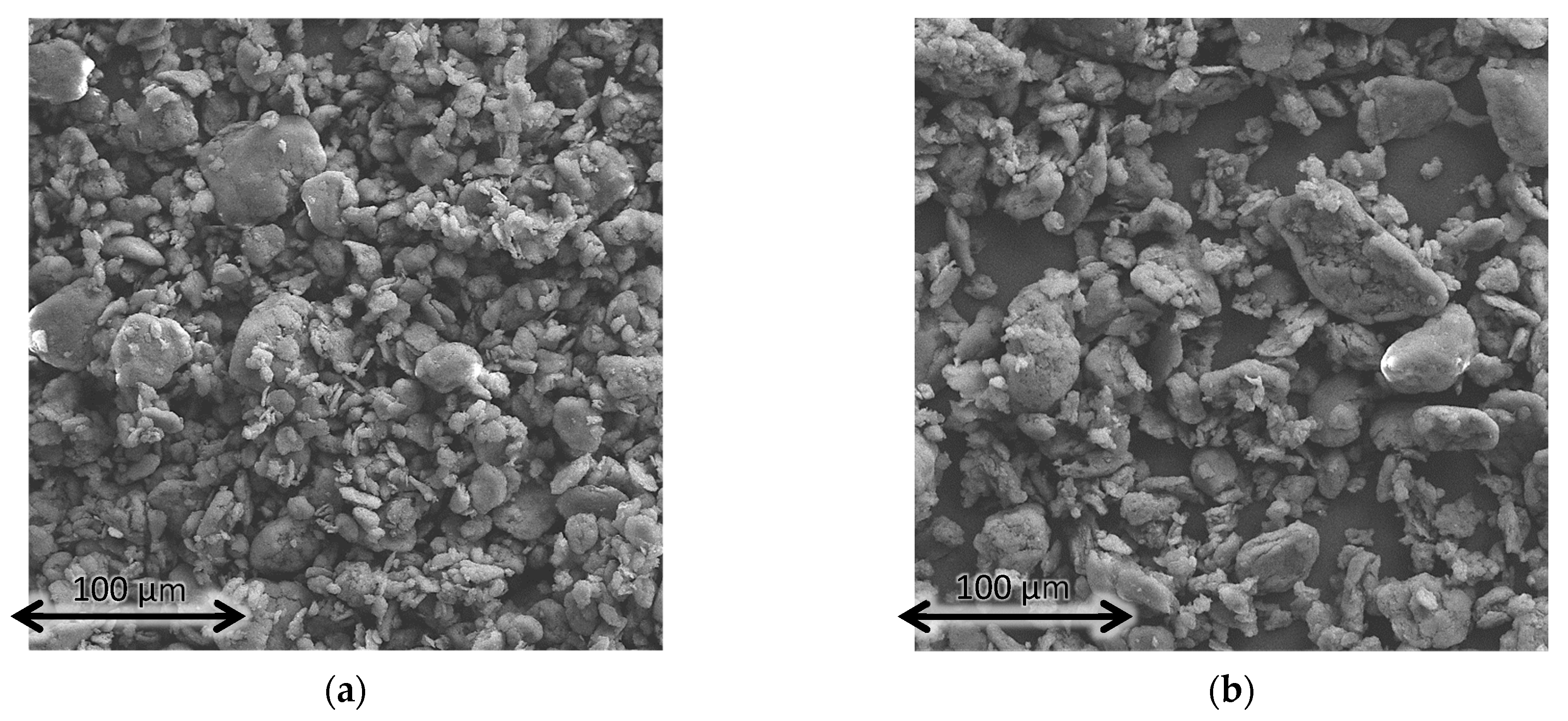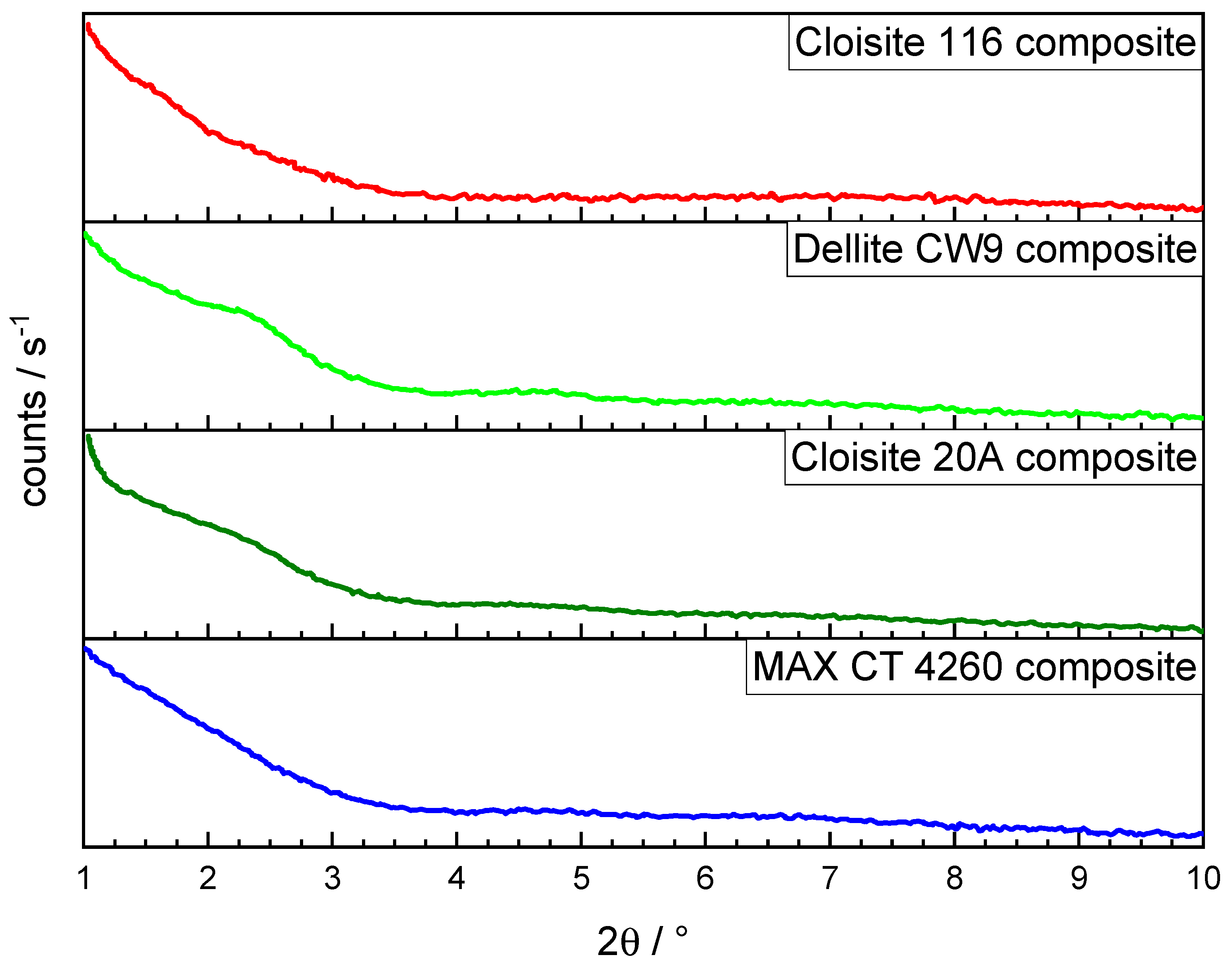Strategies to Cope with Inferior Long-Term Photostability of Bentonite Polyolefin Nanocomposites
Abstract
:1. Introduction
2. Materials and Methods
3. Results and Discussion
3.1. Thermal Analysis of Bentonites
3.2. Adsorption Analysis of Bentonites
3.3. Particle Analysis of Bentonites
3.4. Interlayer Distances of Bentonites
3.5. Long-Term Photostability of Flame-Retardant Bentonite Nanocomposites
4. Conclusions
Supplementary Materials
Author Contributions
Funding
Institutional Review Board Statement
Data Availability Statement
Acknowledgments
Conflicts of Interest
References
- Beyer, G. Flame Retardancy of Nanocomposites—From Research to Technical Products. J. Fire Sci. 2005, 23, 75–87. [Google Scholar] [CrossRef]
- Colombani, J.; Sidi, A.; Larché, J.-F.; Taviot-Gueho, C.; Rivaton, A. Thermooxidative degradation of crosslinked EVA/EPDM copolymers: Impact of Aluminium TriHydrate (ATH) filler incorporation. Polym. Degrad. Stab. 2018, 153, 130–144. [Google Scholar] [CrossRef]
- Chang, L.N.; Chow, W.S. Accelerated Weathering on Glass Fiber/Epoxy/Organo-montmorillonite Nanocomposites. J. Compos. Mater. 2010, 44, 1421–1434. [Google Scholar] [CrossRef]
- Pandey, J.K.; Raghunatha Reddy, K.; Pratheep Kumar, A.; Singh, R.P. An overview on the degradability of polymer nanocomposites. Polym. Degrad. Stab. 2005, 88, 234–250. [Google Scholar] [CrossRef]
- Bae, J.W.; Yang, T.U.; Nam, G.J.; Lee, G.J.; Nam, B.-U.; Jho, J.Y. Dispersion and flame retardancy of ethylene vinylacetate/layered silicate nanocomposites using the masterbatch approach for cable insulating material. Polym. Bull. 2011, 67, 729–740. [Google Scholar] [CrossRef]
- Xie, W.; Gao, Z.; Liu, K.; Pan, W.-P.; Vaia, R.; Hunter, D.; Singh, A. Thermal characterization of organically modified montmorillonite. Thermochim. Acta 2001, 367–368, 339–350. [Google Scholar] [CrossRef]
- Qin, H.; Zhao, C.; Zhang, S.; Chen, G.; Yang, M. Photo-oxidative degradation of polyethylene/montmorillonite nanocomposite. Polym. Degrad. Stab. 2003, 81, 497–500. [Google Scholar] [CrossRef]
- Xie, W.; Xie, R.; Pan, W.-P.; Hunter, D.; Koene, B.; Tan, L.-S.; Vaia, R. Thermal Stability of Quaternary Phosphonium Modified Montmorillonites. Chem. Mater. 2002, 14, 4837–4845. [Google Scholar] [CrossRef]
- Shah, R.K.; Paul, D.R. Organoclay degradation in melt processed polyethylene nanocomposites. Polymer 2006, 47, 4075–4084. [Google Scholar] [CrossRef]
- Tidjani, A.; Wilkie, C.A. Photo-oxidation of polymeric-inorganic nanocomposites: Chemical, thermal stability and fire retardancy investigations. Polym. Degrad. Stab. 2001, 64, 33–37. [Google Scholar] [CrossRef]
- Diagne, M.; Guèye, M.; Dasilva, A.; Tidjani, A. Comparative photo-oxidation under natural and accelerated conditions of polypropylene nanocomposites produced by extrusion and injection molding. J. Appl. Polym. Sci. 2007, 105, 3789–3793. [Google Scholar] [CrossRef]
- Mailhot, B.; Morlat, S.; Gardette, J.-L.; Boucard, S.; Duchet, J.; Gérard, J.-F. Photodegradation of polypropylene nanocomposites. Polym. Degrad. Stab. 2003, 82, 163–167. [Google Scholar] [CrossRef]
- Pavlidou, S.; Papaspyrides, C.D. A review on polymer–layered silicate nanocomposites. Prog. Polym. Sci. 2008, 33, 1119–1198. [Google Scholar] [CrossRef]
- Chmela, S.; Kleinová, A.; Fiedlerová, A.; Borsig, E.; Kaempfer, D.; Thomann, R.; Mülhaupt, R. Photo-Oxidation of sPP/Organoclay Nanocomposites. J. Macromol. Sci. A 2005, 42, 821–829. [Google Scholar] [CrossRef]
- Morlat, S.; Mailhot, B.; Gonzalez, D.; Gardette, J.-L. Photo-oxidation of Polypropylene/Montmorillonite Nanocomposites. 1. Influence of Nanoclay and Compatibilizing Agent. Chem. Mater. 2004, 16, 377–383. [Google Scholar] [CrossRef]
- Qin, H.; Zhang, Z.; Feng, M.; Gong, F.; Zhang, S.; Yang, M. The influence of interlayer cations on the photo-oxidative degradation of polyethylene/montmorillonite composites. J. Polym. Sci. B Polym. Phys. 2004, 42, 3006–3012. [Google Scholar] [CrossRef]
- Allen, N.S.; Edge, M.; Corrales, T.; Childs, A.; Liauw, C.M.; Catalina, F.; Peinado, C.; Minihan, A.; Aldcroft, D. Ageing and stabilisation of filled polymers: An overview. Polym. Degrad. Stab. 1998, 61, 183–199. [Google Scholar] [CrossRef]
- Morlat-Therias, S.; Mailhot, B.; Gardette, J.-L.; Da Silva, C.; Haidar, B.; Vidal, A. Photooxidation of ethylene-propylene-diene/montmorillonite nanocomposites. Polym. Degrad. Stab. 2005, 90, 78–85. [Google Scholar] [CrossRef]
- Xie, W.; Gao, Z.; Pan, W.-P.; Hunter, D.; Singh, A.; Vaia, R. Thermal Degradation Chemistry of Alkyl Quaternary Ammonium Montmorillonite. Chem. Mater. 2001, 13, 2979–2990. [Google Scholar] [CrossRef]
- La Mantia, F.P.; Dintcheva, N.T.; Malatesta, V.; Pagani, F. Improvement of photo-stability of LLDPE-based nanocomposites. Polym. Degrad. Stab. 2006, 91, 3208–3213. [Google Scholar] [CrossRef]
- Pfaendner, R. Nanocomposites: Industrial opportunity or challenge? Polym. Degrad. Stab. 2010, 95, 369–373. [Google Scholar] [CrossRef]
- Dintcheva, N.T.; Al-Malaika, S.; Arrigo, R.; Morici, E. Novel strategic approach for the thermo- and photo- oxidative stabilization of polyolefin/clay nanocomposites. Polym. Degrad. Stab. 2017, 145, 41–51. [Google Scholar] [CrossRef]
- Allen, N.S.; Edge, M.; Ortega, A.; Sandoval, G.; Liauw, C.M.; Verran, J.; Stratton, J.; McIntyre, R.B. Degradation and stabilisation of polymers and coatings: Nano versus pigmentary titania particles. Polym. Degrad. Stab. 2004, 85, 927–946. [Google Scholar] [CrossRef]
- Bertin, D.; Boutevin, B.; Rigal, G.; Fourty, G. Study of Talc-Additive Interactions by Combined TGA-FTIR System. Eur. Polym. J. 1998, 34, 163–170. [Google Scholar]
- Xi, Y.; Zhou, Q.; Frost, R.L.; He, H. Thermal stability of octadecyltrimethylammonium bromide modified montmorillonite organoclay. J. Colloid Interface Sci. 2007, 311, 347–353. [Google Scholar] [CrossRef] [PubMed]
- Yue, X.; Li, C.; Ni, Y.; Xu, Y.; Wang, J. Flame retardant nanocomposites based on 2D layered nanomaterials: A review. J. Mater. Sci. 2019, 54, 13070–13105. [Google Scholar] [CrossRef]
- Chuang, T.-H.; Guo, W.; Cheng, K.-C.; Chen, S.-W.; Wang, H.-T.; Yen, Y.-Y. Thermal Properties and Flammability of Ethylene-Vinyl-Acetate Copolymer /Montmorillonite /Polyethylene Nanocomposites with Flame Retardants. J. Polym. Res. 2004, 11, 169–174. [Google Scholar] [CrossRef]
- Zhao, C.; Qin, H.; Gong, F.; Feng, M.; Zhang, S.; Yang, M. Mechanical, thermal and flammability properties of polyethylene/clay nanocomposites. Polym. Degrad. Stab. 2005, 87, 183–189. [Google Scholar] [CrossRef]
- Tabak, A.; Afsin, B.; Aygun, S.F.; Koksal, E. Structural characteristics of organo-modified bentonites of different origin. J. Therm. Anal. Calorim. 2007, 87, 375–381. [Google Scholar] [CrossRef]
- Liu, Z.; Uddin, M.A.; Sun, Z. FT-IR and XRD analysis of natural Na-bentonite and Cu(II)-loaded Na-bentonite. Spectrochim. Acta A 2011, 79, 1013–1016. [Google Scholar] [CrossRef]
- Pluta, M.; Paul, M.-A.; Alexandre, M.; Dubois, P. Plasticized polylactide/clay nanocomposites. I. The role of filler content and its surface organo-modification on the physico-chemical properties. J. Polym. Sci. B Polym. Phys. 2006, 44, 299–311. [Google Scholar] [CrossRef]
- Schartel, B.; Hull, T.R. Development of fire-retarded materials—Interpretation of cone calorimeter data. Fire Mater. 2007, 31, 327–354. [Google Scholar] [CrossRef]
- Dintcheva, N.; Al-Malaika, S.; La Mantia, F.P. Effect of extrusion and photo-oxidation on polyethylene/clay nanocomposites. Polym. Degrad. Stab. 2009, 94, 1571–1588. [Google Scholar] [CrossRef]
- Morlat-Therias, S.; Mailhot, B.; Gonzalez, D.; Gardette, J.-L. Photooxidation of Polypropylene/Montmorillonite Nanocomposites. 2. Interactions with Antioxidants. Chem. Mater. 2005, 17, 1072–1078. [Google Scholar] [CrossRef]








| Bentonite | Specific Surface Area /m2·g−1 | Median Pore Diameter /nm | Cumulative Pore Volume /cm3·g−1 |
|---|---|---|---|
| Cloisite 116 | 29.79 | 5.992 | 0.0753 |
| MAX CT 4260 | 15.10 | 14.67 | 0.0593 |
| Cloisite 20A | 18.51 | 15.46 | 0.0628 |
| Dellite CW9 | 15.40 | 11.65 | 0.0363 |
| Bentonite | Maximum of Distribution/µm | FWHM/µm |
|---|---|---|
| Cloisite 116 | 14.45 | 14.78 |
| MAX CT 4260 | 15.88 | 17.43 |
| Cloisite 20A | 10.02 | 10.17 |
| Dellite CW9 | 12.38 | 11.09 |
| Bentonite | PHRR/kW·m−2 | THR/MJ·m−2 | TSR/m2·m−2 | MARHE/kW·m−2 | Residue/% |
|---|---|---|---|---|---|
| No bentonite | 182 ± 22 | 56.4 ± 5.3 | 279 ± 115 | 95.5 ± 14.7 | 42.6 ± 1.3 |
| MAX CT 4260 | 102 ± 15 | 50.6 ± 9.2 | 203 ± 85 | 59.4 ± 12.2 | 43.9 ± 3.4 |
| Cloisite 20A | 100 ± 5 | 47.3 ± 1.8 | 131 ± 17 | 57.5 ± 2.4 | 44.9 ± 0.1 |
| Dellite CW9 | 92 ± 7 | 43.6 ± 4.6 | 135 ± 53 | 52.9 ± 6.1 | 46.0 ± 0.8 |
| Cloisite 116 | 113 ± 1 | 52.9 ± 1.1 | 270 ± 56 | 74.3 ± 1.4 | 44.4 ± 1.0 |
Disclaimer/Publisher’s Note: The statements, opinions and data contained in all publications are solely those of the individual author(s) and contributor(s) and not of MDPI and/or the editor(s). MDPI and/or the editor(s) disclaim responsibility for any injury to people or property resulting from any ideas, methods, instructions or products referred to in the content. |
© 2024 by the authors. Licensee MDPI, Basel, Switzerland. This article is an open access article distributed under the terms and conditions of the Creative Commons Attribution (CC BY) license (https://creativecommons.org/licenses/by/4.0/).
Share and Cite
Westphal, E.; Geertz, G.; Großhauser, M.; Metzsch-Zilligen, E.; Pfaendner, R. Strategies to Cope with Inferior Long-Term Photostability of Bentonite Polyolefin Nanocomposites. Polymers 2024, 16, 535. https://doi.org/10.3390/polym16040535
Westphal E, Geertz G, Großhauser M, Metzsch-Zilligen E, Pfaendner R. Strategies to Cope with Inferior Long-Term Photostability of Bentonite Polyolefin Nanocomposites. Polymers. 2024; 16(4):535. https://doi.org/10.3390/polym16040535
Chicago/Turabian StyleWestphal, Erik, Guru Geertz, Michael Großhauser, Elke Metzsch-Zilligen, and Rudolf Pfaendner. 2024. "Strategies to Cope with Inferior Long-Term Photostability of Bentonite Polyolefin Nanocomposites" Polymers 16, no. 4: 535. https://doi.org/10.3390/polym16040535
APA StyleWestphal, E., Geertz, G., Großhauser, M., Metzsch-Zilligen, E., & Pfaendner, R. (2024). Strategies to Cope with Inferior Long-Term Photostability of Bentonite Polyolefin Nanocomposites. Polymers, 16(4), 535. https://doi.org/10.3390/polym16040535






